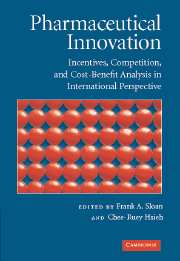 Pharmaceutical Innovation
Pharmaceutical Innovation Published online by Cambridge University Press: 18 December 2009
Introduction and Overview
Judged in terms of the relationship of benefit to cost, vaccines are among the most socially valuable public health investments (U.S. Centers for Disease Control and Prevention [CDC] 1999; Stratton, Durch, and Lawrence 2000). In spite of some recent successes, such as increases in immunization rates in the United States (CDC 2002a, b, 2003), substantial structural and financial problems remain. In particular, the United States has recently experienced unprecedented shortages in 8 of the 11 routine childhood vaccines (Georges et al. 2003). Flu vaccine shortages were experienced in 2000–2002 and 2004 (Cohen 2002; Enserink 2004; Institute of Medicine 2004).
Although unique causes have been attributed to each shortage, a common pattern remains. In the past three decades, the number of firms producing vaccines for the U.S. market has decreased. Between 1966 and 1980, more than half of all commercial vaccine manufacturers stopped producing vaccines, and the exodus has continued to the present (Cohen 2002). As of early 2004, only five companies produced all vaccines recommended for routine use by children and adults, and only three of these were U.S.-based firms. Eight major vaccine products – including MMR (measles-mumps-rubella), tetanus, and polio – each had only one supplier (Institute of Medicine 2004). A long-term shutdown in capacity by any one of these companies could be a major supply shock, as occurred with the disruption in supply of flu vaccine from a Chiron plant in October 2004, which cut the supply of vaccine to the United States by almost half (Enserink 2004).
To save this book to your Kindle, first ensure [email protected] is added to your Approved Personal Document E-mail List under your Personal Document Settings on the Manage Your Content and Devices page of your Amazon account. Then enter the ‘name’ part of your Kindle email address below. Find out more about saving to your Kindle.
Note you can select to save to either the @free.kindle.com or @kindle.com variations. ‘@free.kindle.com’ emails are free but can only be saved to your device when it is connected to wi-fi. ‘@kindle.com’ emails can be delivered even when you are not connected to wi-fi, but note that service fees apply.
Find out more about the Kindle Personal Document Service.
To save content items to your account, please confirm that you agree to abide by our usage policies. If this is the first time you use this feature, you will be asked to authorise Cambridge Core to connect with your account. Find out more about saving content to Dropbox.
To save content items to your account, please confirm that you agree to abide by our usage policies. If this is the first time you use this feature, you will be asked to authorise Cambridge Core to connect with your account. Find out more about saving content to Google Drive.